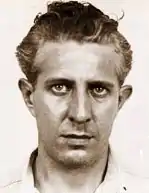Richard Quirin
Richard Quirin (April 26, 1908 – August 8, 1942) was a German agent executed as a spy for Nazi Germany in World War II. He was one of eight agents involved in Operation Pastorius, and gave his name to the Supreme Court decision on the trial, Ex parte Quirin.
Richard Quirin | |
|---|---|
 Richard Quirin mugshot | |
| Born | April 26, 1908 |
| Died | August 8, 1942 (aged 34) D.C. Jail, Washington, D.C., U.S. |
| Cause of death | Execution by electrocution |
| Other names | Richard Quintas |
| Occupation | Mechanic |
| Criminal status | Deceased |
| Criminal charge | Espionage and sabotage |
| Penalty | Death by electrocution |
| Espionage activity | |
| Allegiance | |
| Battles/wars | Operation Pastorius |
Early life
Born in Berlin, Germany in 1908, Quirin moved to the United States in 1927, living in Schenectady, New York. He worked as a mechanic during this time for General Electric.[1] He lived in the United States from 1927 to 1939, and was a member of the German American Bund, as well as an open supporter of the Hitler regime.[2] In 1939, Quirin and his wife returned to Germany. Upon his return, he got a job with Volkswagen.[2] He worked with Heinrich Heinck at the plant in Braunschweig, and the two became the first recruited by Walter Kappe, the publisher of the Bund newspaper Deutscher Weckruf und Beobachter, for what became Operation Pastorius.[3]
Operation Pastorius
After the men were recruited, they were given pseudonyms and false stories to blend in as they returned to America. Quirin's new identity was Richard Quintas, a Portuguese man who moved to Upstate New York from Lisbon when he was three.[4] He was considered by Kappe to be a "cool, cruel man who would not hesitate to kill anyone to accomplish the mission's objectives."[2] On June 13, 1942, Quirin was one of the first four to come to America as he, George John Dasch, Heinck, and Ernst Peter Burger landed on American soil on a U-boat.[5] Several days later, when Dasch turned himself in to the FBI, he named Quirin as one of the "true believers" of the operation.[6] On June 20, Quirin was the first to be arrested, FBI officers surrounding him as he tried to escape.[7]
Trial and execution
At the trial, Quirin took the stand after Heinck. He stated that he did not know the purpose of Operation Pastorius, and was just interested in returning to the United States.[8] However, a cross-examination showed that Quirin saw himself as a loyal Nazi and had made no effort to get out of the operation.[8] Quirin was emotionless as he was sentenced to death, only displaying sentiment when telling a guard that he wanted his contacts to know Dasch had "ratted" him out.[9] Quirin and the five others were electrocuted on August 8, 1942, and buried in a potter's field with numbered graves.[10]
Notes
- Breuer, William B. (2003). The air-raid warden was a spy. John Wiley and Sons. p. 228. ISBN 978-0-471-23488-3.
- Abella, 31
- Abella, 20
- Johnson, 51
- Johnson, 101
- Abella, 86
- Johnson, 129
- Johnson, 187
- Abella, 199
- Abella, 207
References
- Abella, Alex; Scott Gordon (2003). Shadow Enemies: Hitler's Secret Terrorist Plot Against the United States. Globe Pequot. pp. 336. ISBN 978-1-59228-142-8.
- Johnson, David Alan (2008). Betrayal: The True Story of J. Edgar Hoover and the Nazi Saboteurs Captured During WWII. Hippocrene Books. p. 288. ISBN 978-0-7818-1173-6.